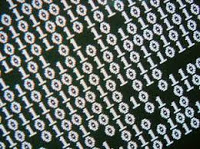The ability of the computer to unset a bit depends on the particular kind of storage. In magnetic storage, such as a spinning-disk hard drive, it magnetizes the region or area that is storing the bit in the opposite direction. In practice, the hard drives write entire blocks at a time; however, the technology could be managed a bit at a time.
In typical flash storage, such as those found in solid-state drives or external flash drives, it doesn’t have the ability to write a single bit at a time. To change a bit from a 1 to a 0, the storage erases an entire block of memory and then rewrites the new data into it.
In DRAM, which is the typical type of RAM found in a computer, it connects the capacitor that is holding the bit to a current drain, which then allows it to discharge. Similarly to the others, a standard DRAM actually can write only a whole line at a time, so switching a single bit also means that you are writing the previous value into all the other bits.
In SRAM, which is mainly used for things like on-CPU caches, the bit line is normally set to 0, and then the write line is set to 1. The transistors would switch into the alternative configuration, and then the current write line will be set back to 0. This specific action causes the bits to maintain their current configuration until they are written again.
How does a computer store data in storage?
A computer is able to store data in storage by utilizing a device called semiconductor memory, which is sometimes known as MOS memory and is responsible for the writing of data on the computer. Most semiconductor memory devices would often have a property of random access, and this random access enables the devices to have a consistent action in accessing and storing data. In addition, the random access properties of the semiconductor memory allow it to access data in random order.
If you compared a semiconductor memory to data storage media like USB flash drives or CDs, you would find that the latter can only write and access data on a consecutive order or in the same sequence that it was written, while the former can write and access data in almost any space of the device.
In addition, semiconductor memory has a noticeably faster rate of storing and writing data than data storage media, and it is estimated that a semiconductor memory can write or read data in just a few nanoseconds compared to CDs that could often take one second to read 1 bit of data.
Because of its fast data writing and reading capabilities, semiconductor memory devices serve as the primary storage for computers, hence the reason why you would typically see a RAM part in almost every computer in the market today.
What are the popular types of RAM?
There are different types of RAM that are available in the market, although there are a few that are more popular than the other because of their superior data writing abilities.
One of the most popular types of RAM is DRAM or dynamic random-access memory, which utilizes a metal-oxide-semiconductor (MOS) memory cells that contain a MOS field-effect transistor (MOSFET) and a MOS capacitor. It is particularly well-known for being the cheapest RAM that computer geeks can buy, and they are also the easiest to find because of their abundance in stores and factories. The one downside to DRAM is that the electric charge responsible for storing data in its memory cells would often leak out slowly, so it would need to be refreshed or rewritten every once in a while. Thankfully, the computer handles the refreshing process of the DRAM.
Another popular type of RAM is SRAM or static random-access memory. This type of RAM is able to store each bit of data inside a circuit, often called as a flip-flop. SRAM is statistically faster than DRAM, although it is relatively more expensive due to the fact that it uses more advanced hardware, and it doesn’t need a memory refresh. Because its memory doesn’t need to be refreshed, the SRAM enables the computer to have faster access to stored data. However, the drawback of SRAM is that it has a high operational power consumption, which means that it may require the computer to consume more energy or electricity, thus resulting in a higher electrical bill for the user’s home or for the company’s office.
The third most popular type of RAM is CAM or content-addressable memory, which is a specialized device that uses data words to return data in the memory. Because it has a unique function, it doesn’t have the same purpose as DRAM and SRAM, although it is still considered an integral part of a modern computer.

